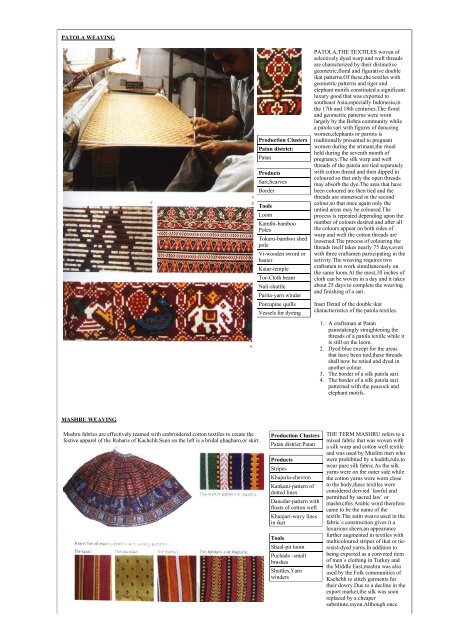PATOLA WEAVING MASHRU WEAVING Production ... - cohands
PATOLA WEAVING MASHRU WEAVING Production ... - cohands
PATOLA WEAVING MASHRU WEAVING Production ... - cohands
Create successful ePaper yourself
Turn your PDF publications into a flip-book with our unique Google optimized e-Paper software.
<strong>PATOLA</strong> <strong>WEAVING</strong><br />
<strong>MASHRU</strong> <strong>WEAVING</strong><br />
Mashru fabrics are effectively teamed with embroidered cotton textiles to create the<br />
festive apparel of the Rabaris of Kachchh.Seen on the left is a bridal ghagharo,or skirt.<br />
<strong>Production</strong> Clusters<br />
Patan district:<br />
Patan<br />
Products<br />
Sari,Scarves<br />
Border<br />
Tools<br />
Loom<br />
Kamthi-bamboo<br />
Poles<br />
Tokaru-bamboo shed<br />
pole<br />
Vi-wooden sword or<br />
beater<br />
Katar-temple<br />
Tor-Cloth beam<br />
Nali-shuttle<br />
Parita-yarn winder<br />
Porcupine quills<br />
Vessels for dyeing<br />
<strong>Production</strong> Clusters<br />
Patan district:Patan<br />
Products<br />
Stripes<br />
Khajuria-chevron<br />
Kankani-pattern of<br />
dotted lines<br />
Danedar-pattern with<br />
floats of cotton weft<br />
Khanjari-wavy lines<br />
in ikat<br />
Tools<br />
Shaal-pit loom<br />
Puchado -small<br />
brushes<br />
Shuttles,Yarn<br />
winders<br />
<strong>PATOLA</strong>,THE TEXTILES woven of<br />
selectively dyed warp and weft threads<br />
are characterized by their distinctive<br />
geometric,floral and figurative double<br />
ikat patterns.Of these,the textiles with<br />
geometric patterns and tiger and<br />
elephant motifs constituted a significant<br />
luxury good that was exported to<br />
southeast Asia,especially Indonesia,in<br />
the 17th and 18th centuries.The floral<br />
and geometric patterns were worn<br />
largely by the Bohra community while<br />
a patola sari with figures of danceing<br />
women,elephants or parrots is<br />
traditionally presented to pregnant<br />
women during the srimant,the ritual<br />
held during the seventh month of<br />
pregnancy.The silk warp and weft<br />
threads of the patola are tied separately<br />
with cotton thread and then dipped in<br />
coloured so that only the open threads<br />
may absorb the dye.The area that have<br />
been coloured are then tied and the<br />
threads are immersed in the second<br />
colour,so that once again only the<br />
untied areas may be coloured.The<br />
process is repeated depending upon the<br />
number of colours desired and after all<br />
the colours appear on both sides of<br />
warp and weft the cotton threads are<br />
loosened.The process of colouring the<br />
threads itself takes nearly 75 days,even<br />
with three craftsmen participating in the<br />
activity.The weaving requires two<br />
craftsmen to work simultaneously on<br />
the same loom.At the most,10 inches of<br />
cloth can be woven in a day and it takes<br />
about 25 days to complete the weaving<br />
and finishing of a sari.<br />
Inset Detail of the double ikat<br />
charactteristics of the patola textiles.<br />
1. A craftsman at Patan<br />
painstakingly straightening the<br />
threads of a patola textile while it<br />
is still on the loom.<br />
2. Dyed blue except for the areas<br />
that have been tied,these threads<br />
shall now be retied and dyed in<br />
another colour.<br />
3. The border of a silk patola sari.<br />
4. The border of a silk patola sari<br />
patterned with the peacock and<br />
elephant motifs.<br />
THE TERM <strong>MASHRU</strong> refers to a<br />
mixed fabric that was woven with<br />
a silk warp and cotton weft textile<br />
and was used by Muslim men who<br />
were prohibited by a hadith,rule,to<br />
wear pure silk fabric.As the silk<br />
yarns were on the outer side while<br />
the cotton yarns were worn close<br />
to the body,these textiles were<br />
considered dervied `lawful and<br />
permitted by sacred law` or<br />
mashru;this Arabic word therefore<br />
came to be the name of the<br />
textile.The satin weave used in the<br />
fabric`s construction gives it a<br />
luxurious sheen,an appearance<br />
further augmented in textiles with<br />
multicoloured stripes of ikat or tieresist-dyed<br />
yarns.In addition to<br />
being exported as a conveted item<br />
of men`s clothing in Turkey and<br />
the Middle East,mashru was also<br />
used by the Folk communities of<br />
Kachchh to stitch garments for<br />
their dowry.Due to a decline in the<br />
export market,the silk was soon<br />
replaced by a cheaper<br />
substitute,rayon.Although once
woven in many areas of the Indian<br />
subcontinent,the tradition of<br />
weaving mashru today survives<br />
only in Patan,north Gujarat and<br />
Mandvi in Kachchh district,both<br />
places in needed of revitalization.


